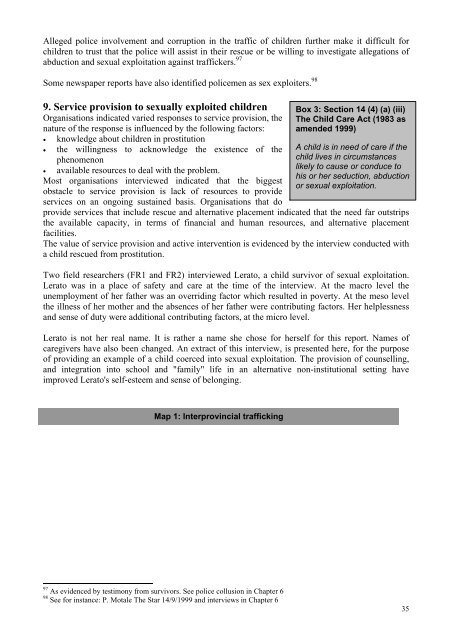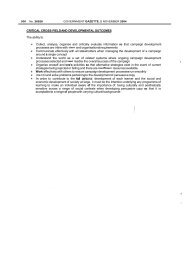The trafficking of children for purposes of sexual exploitation
The trafficking of children for purposes of sexual exploitation
The trafficking of children for purposes of sexual exploitation
Create successful ePaper yourself
Turn your PDF publications into a flip-book with our unique Google optimized e-Paper software.
Alleged police involvement and corruption in the traffic <strong>of</strong> <strong>children</strong> further make it difficult <strong>for</strong><br />
<strong>children</strong> to trust that the police will assist in their rescue or be willing to investigate allegations <strong>of</strong><br />
abduction and <strong>sexual</strong> <strong>exploitation</strong> against traffickers. 97<br />
Some newspaper reports have also identified policemen as sex exploiters. 98<br />
9. Service provision to <strong>sexual</strong>ly exploited <strong>children</strong><br />
Organisations indicated varied responses to service provision, the<br />
nature <strong>of</strong> the response is influenced by the following factors:<br />
• knowledge about <strong>children</strong> in prostitution<br />
• the willingness to acknowledge the existence <strong>of</strong> the<br />
phenomenon<br />
• available resources to deal with the problem.<br />
Most organisations interviewed indicated that the biggest<br />
obstacle to service provision is lack <strong>of</strong> resources to provide<br />
services on an ongoing sustained basis. Organisations that do<br />
Box 3: Section 14 (4) (a) (iii)<br />
<strong>The</strong> Child Care Act (1983 as<br />
amended 1999)<br />
A child is in need <strong>of</strong> care if the<br />
child lives in circumstances<br />
likely to cause or conduce to<br />
his or her seduction, abduction<br />
or <strong>sexual</strong> <strong>exploitation</strong>.<br />
provide services that include rescue and alternative placement indicated that the need far outstrips<br />
the available capacity, in terms <strong>of</strong> financial and human resources, and alternative placement<br />
facilities.<br />
<strong>The</strong> value <strong>of</strong> service provision and active intervention is evidenced by the interview conducted with<br />
a child rescued from prostitution.<br />
Two field researchers (FR1 and FR2) interviewed Lerato, a child survivor <strong>of</strong> <strong>sexual</strong> <strong>exploitation</strong>.<br />
Lerato was in a place <strong>of</strong> safety and care at the time <strong>of</strong> the interview. At the macro level the<br />
unemployment <strong>of</strong> her father was an overriding factor which resulted in poverty. At the meso level<br />
the illness <strong>of</strong> her mother and the absences <strong>of</strong> her father were contributing factors. Her helplessness<br />
and sense <strong>of</strong> duty were additional contributing factors, at the micro level.<br />
Lerato is not her real name. It is rather a name she chose <strong>for</strong> herself <strong>for</strong> this report. Names <strong>of</strong><br />
caregivers have also been changed. An extract <strong>of</strong> this interview, is presented here, <strong>for</strong> the purpose<br />
<strong>of</strong> providing an example <strong>of</strong> a child coerced into <strong>sexual</strong> <strong>exploitation</strong>. <strong>The</strong> provision <strong>of</strong> counselling,<br />
and integration into school and "family" life in an alternative non-institutional setting have<br />
improved Lerato's self-esteem and sense <strong>of</strong> belonging.<br />
Map 1: Interprovincial <strong>trafficking</strong><br />
97 As evidenced by testimony from survivors. See police collusion in Chapter 6<br />
98 See <strong>for</strong> instance: P. Motale <strong>The</strong> Star 14/9/1999 and interviews in Chapter 6<br />
35
















